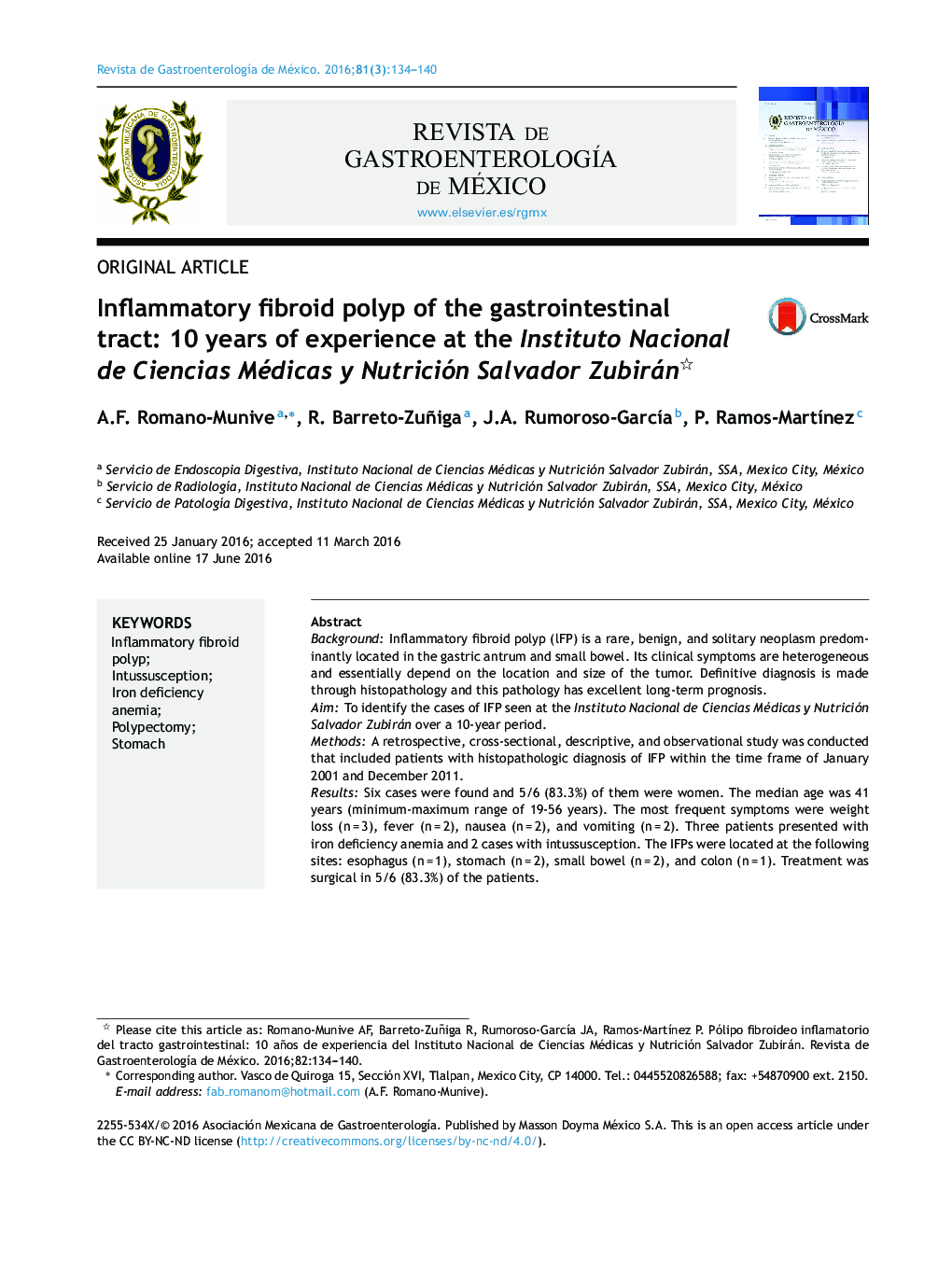| کد مقاله | کد نشریه | سال انتشار | مقاله انگلیسی | نسخه تمام متن |
|---|---|---|---|---|
| 3318992 | 1590389 | 2016 | 7 صفحه PDF | دانلود رایگان |
BackgroundInflammatory fibroid polyp (lFP) is a rare, benign, and solitary neoplasm predominantly located in the gastric antrum and small bowel. Its clinical symptoms are heterogeneous and essentially depend on the location and size of the tumor. Definitive diagnosis is made through histopathology and this pathology has excellent long-term prognosis.AimTo identify the cases of IFP seen at the Instituto Nacional de Ciencias Médicas y Nutrición Salvador Zubirán over a 10-year period.MethodsA retrospective, cross-sectional, descriptive, and observational study was conducted that included patients with histopathologic diagnosis of IFP within the time frame of January 2001 and December 2011.ResultsSix cases were found and 5/6 (83.3%) of them were women. The median age was 41 years (minimum-maximum range of 19-56 years). The most frequent symptoms were weight loss (n = 3), fever (n = 2), nausea (n = 2), and vomiting (n = 2). Three patients presented with iron deficiency anemia and 2 cases with intussusception. The IFPs were located at the following sites: esophagus (n = 1), stomach (n = 2), small bowel (n = 2), and colon (n = 1). Treatment was surgical in 5/6 (83.3%) of the patients.ConclusionsIFPs are extremely rare in our population. They usually present with weight loss and iron deficiency anemia and are more frequently located in the stomach and small bowel. This is the largest reported IFP case series in a Mexican population.
ResumenAntecedentesEl pólipo fibroideo inflamatorio (PFI) es una neoplasia rara, benigna y solitaria, predomina en el antro gástrico y el intestino delgado. Los síntomas clínicos son heterogéneos, dependen fundamentalmente de la localización y el tamaño del tumor. El diagnóstico definitivo se establece mediante histopatología y su pronóstico es excelente a largo plazo.ObjetivoIdentificar los casos de PFI en el Instituto Nacional de Ciencias Médicas y Nutrición Salvador Zubirán en un período de 10 años.MétodosEstudio observacional, descriptivo, transversal y retrospectivo, se incluyó a los pacientes con diagnóstico histopatológico de PFI desde enero del 2001 hasta diciembre del 2011.ResultadosSe encontraron 6 casos, 5/6 (83.3%) fueron mujeres. La mediana de edad fue de 41 años (rango mínimo-máximo de 19 a 56 años). Los síntomas más frecuentes fueron pérdida de peso (n = 3), fiebre (n = 2), náuseas (n = 2) y vómito (n = 2). Tres pacientes cursaron con anemia ferropénica. Dos casos se presentaron con intususcepción. La localización de los PFI fue la siguiente: esófago (n = 1), estómago (n = 2), intestino delgado (n = 2) y colon (n = 1). El tratamiento fue quirúrgico en 5/6 (83.3%) pacientes.ConclusionesLos PFI son extremadamente raros en nuestra población, suelen presentarse con pérdida de peso y anemia ferropénica, se localizan con mayor frecuencia en el estómago y el intestino delgado. Esta es la serie de casos más grande de PFI que se ha reportado en población mexicana.
Journal: Revista de Gastroenterología de México (English Edition) - Volume 81, Issue 3, July–September 2016, Pages 134–140
